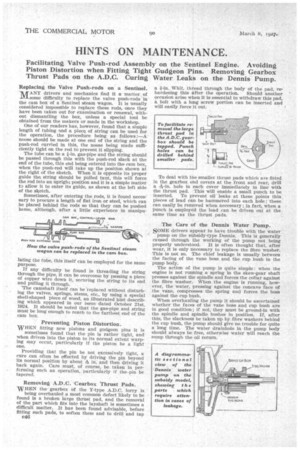HINTS ON MAINTENANCE.
Page 68

If you've noticed an error in this article please click here to report it so we can fix it.
Facilitating Valve Push-rod Assembly on the Sentinel Engine. Avoiding Piston Distortion when Fitting Tight Gudgeon Pins. Removing Gearbox Thrust Pads on the A.D.C. Curing Water Leaks on the Dennis Pump.
Replacing the Valve Push-rods on a Sentinel.
lir ANY drivers and mechanics find it a matter of -1Y-I-some difficulty to replace the valve push-rods in the cam box of a Sentinel steam wagon. It is usually considered impossible to replace these rods, once they have been taken out for examination or renewal, without dismantling the box, unless a special tool be obtained from the makers or made in the workshop.
One of our readers has, however, found that a simple length of tubing and a piece of string can be used for the operation, the procedure being as follows :—A noose should be made at one end of the string and the push-rod carried in this, the noose being made sufficiently tight on the rod to prevent it slipping.
The tube can be a fin, gas-pipe and the string should be passed through this with the push-rod slack at the end of the tube, this end being entered into the cam box, when the push-rod will take up the position shown at the right of the sketch. When it is opposite its proper guide tIm string should be pulled taut, this will force the rod into an upright position and it is a simple matter ta allow it to enter its guide, as shown at the left side of the sketch.
Sometimes, after entering the rods, it is found necessary to procure a length of flat iron or steel, which can be placed behind the rods so that they can be pushed home; although, after a little experience in manipu lating the tube, this itself can be employed for the same purpose.
If any difficulty be found in threading the string through the pipe, it can be overcome by passing a piece of copper wire down it, securing the string to its end and pulling it through.
-The camshaft itself can be replaced without disturb.. ing the valves, springs, stems, etc., by using a special shell-shaped piece of wood, an illustrated hint describing which appeared in our issue dated October 21st, 1924. It should be noted that the gas-pipe and string must be long enough to reach to the farthest end of the cam box.
Preventing Piston Distortion.
WHEN fitting new pistons and gudgeon pins it is sometimes found that the pin is rather tight, and when driven into the piston to its normal extent warping may occur, particularly if the piston be a light one.
Providing that the pin be not excessively tight, a cure can often be effected by driving the pin beyond
its normal position by about in. and then driving it back again. Care must, of course, be taken in perferming such an operation, particularly if the pin be tapered.
Removing A.D.C. Cearbox Thrust Pads.
WHEN the gearbox of the Y-type A.D.C. lorry is
being overhauled a most common defect likely to be found is a broken large thrust pad, and the removal of the part which fits into the layshaft is sometimes a difficult matter. It has been found advisable, before fitting such pads, to soften them and to drill and tap
a fin. Whit, thread through the body of the pad, rehardening this after the operation. Should another occasion arise when it is essential to withdraw this pad, it bolt with a long screw portion can be inserted and will easily force it out.
To deal with toe smaller thrust pads which are fitted in the gearbox end covers at the front and rear, drill a *-1n. hole in each cover immediately in line with the thrust pad. This will enable a small punch to be
inserted. To prevent oil leaks at these points thin pieces of lead can be hammered into each hole; these can easily be removed when necessary ; in fact-, when a Punch is employed the lead can be driven out at the same time as the thrust pads.
The Care of the Dennis Water Pump.
SOME drivers appear to have trouble with the water
pump on the subsidy-type Dennis. This is generally caused through the working of the pump not , being properly understood. It is often thought that, after wear, it is only necessary to replace the fibre washer. This is not so. The chief leakage is usually between the facing of the vane boss and the cup bush in the pump body. The action of the pump is quite simple: when the engine is not running a spring in the skew-gear shaft presses against the spindle and forces the collar against the fibre washer. When the engine is running, however, the water, pressing against the concave face of the vane, compresses the spring and forces the boss against the cup bush.
When overhauling the pump it should be ascertained whether the faces of the vane boss and cup bush are in good condition ; if not, they must be ground-in with the spindle and spindle hushes in position. If, after this, the slackness be taken up by fibre washers behind the cup bush, the pump should give no trouble for quite a long time. The water drainhole in the pump body should always be free, otherwise water will reach the sump through the oil return.












































































































